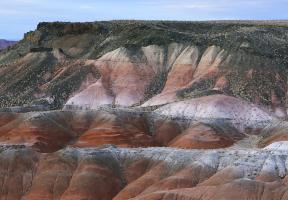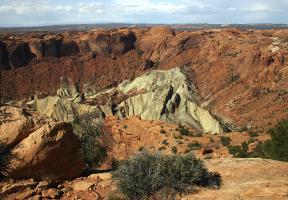How They Work: Turbo Generators
10 min read
A turbo generator is a turbine connected to a generator, which together transform the of a moving fluid, such as liquid water, steam, natural gas or air, into .

© FREDERICK FLORIN / AFP - The moving part of a huge General Electric gas turbine at the company's plant in Belfort, France. Hot gas moves through the blades as it exits the combustion chamber.
Turbines vary significantly depending on their application; they can be used to harness the of the wind in a wind turbine, the water of a river or barrier lake in a hydropower plant, the hot gas in a thermal power plant or the steam created in a 1.
Turbines harness a system of blades to spin and, via a shaft, drive the generator. The generator is made up of a moving part, the rotor, and a stationary part, the stator. The outer layer of the rotor is coated in electromagnets and the interior wall of the stator is lined with coils of copper wire. When the rotor turns, it creates a rotating magnetic field, which induces an in the stator.
The electricity generated is run through a transformer, which increases the voltage to the appropriate level for use in the power transmission system.
Below are four examples of uses for turbo generators.
Hydropower Plants
Humans have been harnessing the power of water to turn blades on an axis since ancient times. The different kinds of turbines – at least in their basic forms – were invented by 19th-century engineers and still bear their names2.
The Pelton wheel extracts energy from the impulse of moving water using small spoon-shaped buckets. It is ideal for high-head hydropower plants (over 200 meters) fed by a reservoir.
With the Francis turbine, water enters the runner tangentially, causing its blades to rotate before exiting through the draft tube located below the turbine. It works best in hydropower plants with medium head (between 30 and 200 meters) on waterways in flat or low-relief areas. The hydropower plant at the Three Gorges Dam in China is equipped with 26 Francis turbines, each with a 710-megawatt output.
The Kaplan turbine is a propeller-type model with blades that can be adjusted depending on the water flow. It is typically installed on run-of-the-river or low-head plants (under 30 meters). The two Kaplan turbines equipping the lakeside Brisay generating station in Canada’s far north, for example, weigh 300 metric tons each and have a combined capacity of 500 megawatts.
Thermal Power Plants
Thermal power plants are equipped with boilers – some up to 90 meters tall – heated by burners fed with ground into a powder, oil vaporized into fine droplets or natural gas injected untreated. The produced is used to increase the temperature of a circuit of water until it turns to steam, which is then run through a series of turbines at high pressure. The turbines power the generator while the steam is evacuated and transformed back into liquid form in a water-cooled condenser.
Pressurized water reactors work on the same principle. The cycle is performed in two clearly separated circuits: the primary circuit is connected to a nuclear reactor, and the secondary circuit to the turbines. The primary circuit transfers the heat produced by the nuclear reaction to the secondary circuit via a . The steam passes through a high-pressure turbine, where it expands partially, and is then directed through several low-pressure turbines. The turbines together can measure up to 60 meters long. The generator turns at a speed of 1,500 revolutions per minute.
Gas Turbines
Gas turbines, also known as combustion turbines, are a form of internal combustion engine (ICE). They are often used in aircraft propulsion as part of turbojet engines. In power generation, hot gas produced in the combustion chamber in the presence of compressed air pushes through the blades causing the turbine to rotate.
The advantage of gas turbine power plants is that they can be built very quickly using industrially manufactured modules. They can be massive, weighing several hundred metric tons and with capacities of up to 600 megawatts.
Combustion turbines are often paired with a facility that recovers some of the heat from the exhaust gas in a process called (i.e., electricity and heat)3.
Wind Turbines
In a conventional wind turbine, sometimes called an aerogenerator, the turbine function is performed by a propeller with three slim blades that face into the wind, known as a rotor. The blades are typically 20 to 40 meters long but can sometimes exceed 70 meters. They are made of fiberglass or carbon fiber for reduced weight.
The speed at which the rotor spins alone is insufficient to generate electricity. Instead, the rotor turns gears that increase the speed to up to 1,500 rotations per minute in the generator. An underground cable connects the wind turbine to a transformer substation that raises the power voltage to 225,000 or 400,000 volts4.
wind turbines have an average capacity of 3 megawatts, compared with 4 to 8 megawatts for models. Output is proportional to the area swept by the rotor and the cube of the wind speed. Air density is also a factor. Some smaller wind turbines may have a vertical axis.
Sources:
- Watch EDF’s video (in French)
- Visit Hydro-Québec’s website (in French) to see drawing of these turbines
- EDF page on combined cycle power plants (in French)
- ENS Rennes video on how wind turbines work (in French)





















